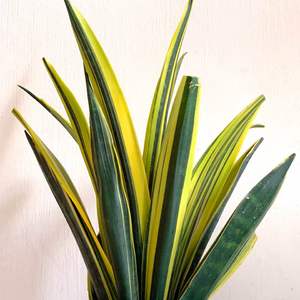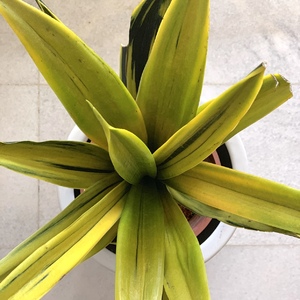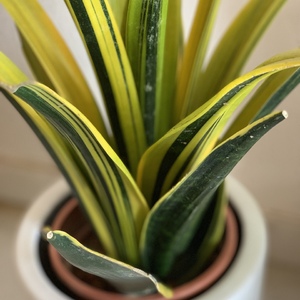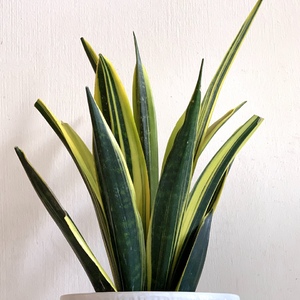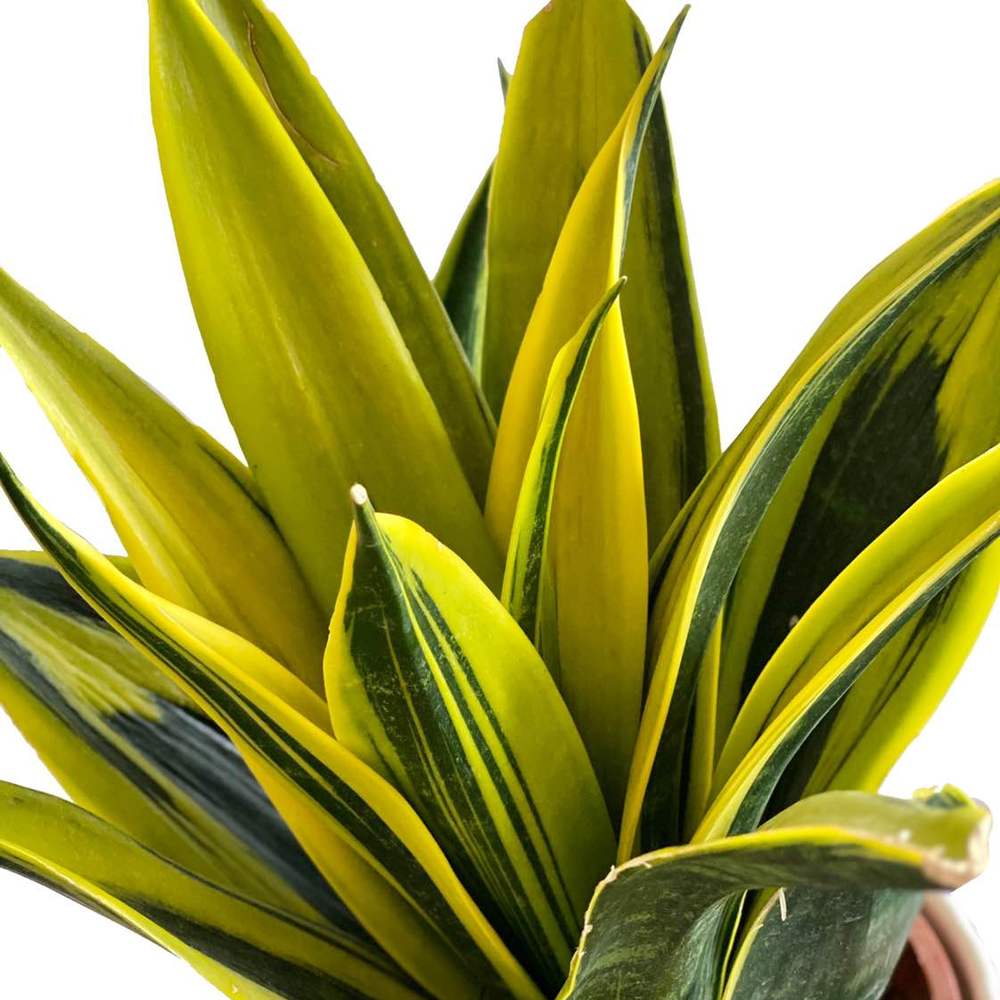植物经验
详细说明
This rare highly variegated species has very thick leaves and tend to arch out in vase forming with proper light, leaves are more open and shorter than typical trifasciata cultivars. The inner emerging leaf on mature plants can be totally golden, as shown in the picture! Coloring will emerge as the plant matures.
Sansevieria Gold Flame is a striking plant grown for its upright, fleshy, sword-shaped leaves. The foliage is highly variegated with contrasting deep green and golden yellow vertical stripes. Ideal for shady areas in warm climates to get that tropical effect and is well suited to pots and containers either indoors or outside in alfresco areas and patios. When planted outdoors, choose a position in dappled shade or a brightly lit position indoors with well drained soil. Sansevieria Gold Flame will grow to a height of 30cm and a width of 1m.
Snake Plant Care
Because the snake plant has succulent leaves, it falls into the category of “set it and forget it” type of houseplants. It doesn’t need much care, water, or light, but you still have to give it a LITTLE bit of love if you want it to thrive.
Light
Give your snake plant bright, indirect light if you want it to do well. While it can survive in low-light conditions, it will grow slower and have less color. A good spot for it would be about 3-6′ away from a window that gets a lot of light.
Water
Because snake plants have succulent leaves, they don’t need a lot of water. Keep the soil slightly moist and never over water. If you water too often your snake plant will become mushy and start to rot quickly.
Soil
The best type of soil for snake plants is an African violet soil mixture with a bit of sand added for additional drainage.
If you’d like to mix your own soil, use this recipe:
1 part garden soil
1 part peat
2 parts perlite or builder’s sand
Fertilizer
To give your snake plant a good chance at thriving, fertilize once monthly during spring and summer. Use a quality houseplant fertilizer that is free of nitrates.
During the winter months, forgo fertilizing completely as the plant grows slowly.
Repotting
You don’t need to re-pot your snake often as it likes to be root-bound. However, if it becomes top heavy and starts to tip over, re-pot it into a pot that is only a couple of inches larger than the current pot.
Pruning
Sometimes the tips of leaves will turn brown or entire leaves will die. If this happens, all you need to do is cut the leaf of right at the soil surface to remove it completely. There’s no point in cutting part of a leaf as it will not grow back from the cut point.
Be sure to use a sterilized cutting instrument!
Snake Plant Propagation
Like most succulent-type plants, propagating snake plants is easily done through leaf cuttings or division.
If you want to preserve the variegation of your snake plant, propagate by division instead of leaf cuttings — if you try via leaf cuttings the plant will revert to green leaves.
Leaf Cutting Propagation Process
Cut a leaf off of your snake plant and slice into 3-4″ pieces. Make sure you remember which side of the leaf is the top and which is the bottom.
Put the cuttings right-side-up in fresh soil mix and keep the pot in an area that gets bright, indirect light.
After about 3-4 weeks, the cuttings will start rooting. After a few months, you’ll have a fresh batch of snake plants to enjoy!
Pests
Like many houseplants, snake plants are susceptible to mealybugs and spider mites. Both of these pests attack the leaves of your spider plant in a similar fashion, sucking the sap out of the leaves.
If you have a heavy infestation, it’s best to just start over with a new plant. But if you catch them arly, you can prevent the infestation from growing.
Combat spider mites by misting the plant and wiping them off. For mealybugs, wipe them off with a cotton swab of rubbing alcohol
Diseases
The most common disease will be a root rot due to over-watering. It’s common because gardeners tend to treat snake plants like other types of houseplants that aren’t succulents, watering on the same schedule.
The solution for root rot is simple: water less, and repot into fresh soil to allow the roots to dry out. You may also need to cut off any mushy leaves.
You may also run into brown rust spots on the leaves, which is caused by allowing water to sit on the leaves during cold or cloudy periods.
Sansevieria Gold Flame is a striking plant grown for its upright, fleshy, sword-shaped leaves. The foliage is highly variegated with contrasting deep green and golden yellow vertical stripes. Ideal for shady areas in warm climates to get that tropical effect and is well suited to pots and containers either indoors or outside in alfresco areas and patios. When planted outdoors, choose a position in dappled shade or a brightly lit position indoors with well drained soil. Sansevieria Gold Flame will grow to a height of 30cm and a width of 1m.
Snake Plant Care
Because the snake plant has succulent leaves, it falls into the category of “set it and forget it” type of houseplants. It doesn’t need much care, water, or light, but you still have to give it a LITTLE bit of love if you want it to thrive.
Light
Give your snake plant bright, indirect light if you want it to do well. While it can survive in low-light conditions, it will grow slower and have less color. A good spot for it would be about 3-6′ away from a window that gets a lot of light.
Water
Because snake plants have succulent leaves, they don’t need a lot of water. Keep the soil slightly moist and never over water. If you water too often your snake plant will become mushy and start to rot quickly.
Soil
The best type of soil for snake plants is an African violet soil mixture with a bit of sand added for additional drainage.
If you’d like to mix your own soil, use this recipe:
1 part garden soil
1 part peat
2 parts perlite or builder’s sand
Fertilizer
To give your snake plant a good chance at thriving, fertilize once monthly during spring and summer. Use a quality houseplant fertilizer that is free of nitrates.
During the winter months, forgo fertilizing completely as the plant grows slowly.
Repotting
You don’t need to re-pot your snake often as it likes to be root-bound. However, if it becomes top heavy and starts to tip over, re-pot it into a pot that is only a couple of inches larger than the current pot.
Pruning
Sometimes the tips of leaves will turn brown or entire leaves will die. If this happens, all you need to do is cut the leaf of right at the soil surface to remove it completely. There’s no point in cutting part of a leaf as it will not grow back from the cut point.
Be sure to use a sterilized cutting instrument!
Snake Plant Propagation
Like most succulent-type plants, propagating snake plants is easily done through leaf cuttings or division.
If you want to preserve the variegation of your snake plant, propagate by division instead of leaf cuttings — if you try via leaf cuttings the plant will revert to green leaves.
Leaf Cutting Propagation Process
Cut a leaf off of your snake plant and slice into 3-4″ pieces. Make sure you remember which side of the leaf is the top and which is the bottom.
Put the cuttings right-side-up in fresh soil mix and keep the pot in an area that gets bright, indirect light.
After about 3-4 weeks, the cuttings will start rooting. After a few months, you’ll have a fresh batch of snake plants to enjoy!
Pests
Like many houseplants, snake plants are susceptible to mealybugs and spider mites. Both of these pests attack the leaves of your spider plant in a similar fashion, sucking the sap out of the leaves.
If you have a heavy infestation, it’s best to just start over with a new plant. But if you catch them arly, you can prevent the infestation from growing.
Combat spider mites by misting the plant and wiping them off. For mealybugs, wipe them off with a cotton swab of rubbing alcohol
Diseases
The most common disease will be a root rot due to over-watering. It’s common because gardeners tend to treat snake plants like other types of houseplants that aren’t succulents, watering on the same schedule.
The solution for root rot is simple: water less, and repot into fresh soil to allow the roots to dry out. You may also need to cut off any mushy leaves.
You may also run into brown rust spots on the leaves, which is caused by allowing water to sit on the leaves during cold or cloudy periods.
花相册 (16)
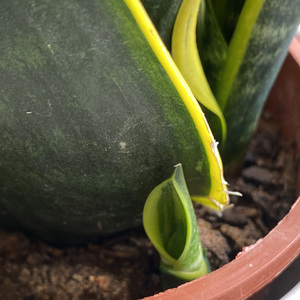
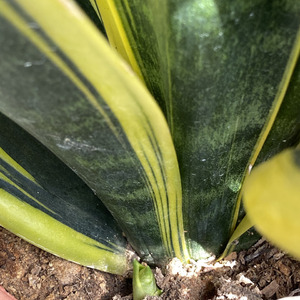
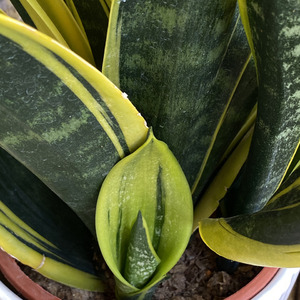
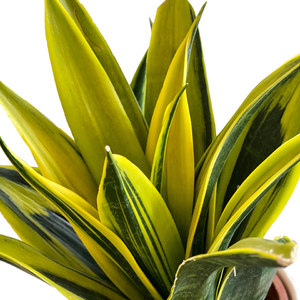
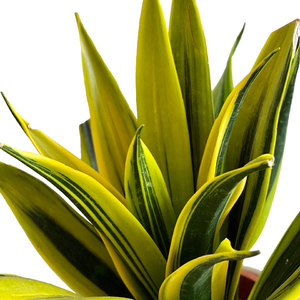
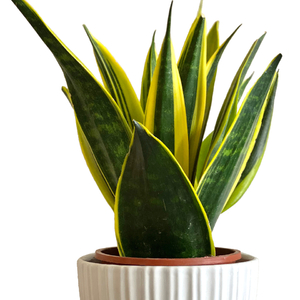
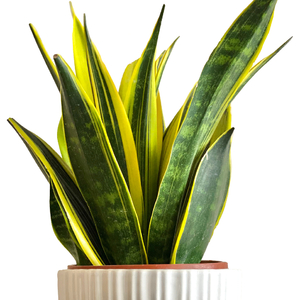
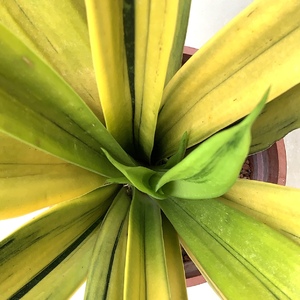
kensong
2020年10月25日

Another pup appears.


kensong
2020年07月15日

Pup growing


kensong
2020年05月26日

Pup appears


kensong
2019年03月31日

New leaves growing well.


kensong
2019年02月02日

I see new leaves. Finally.
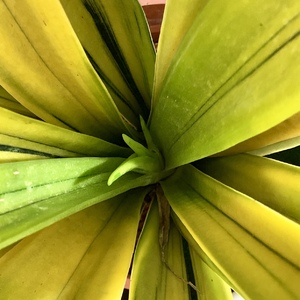

kensong
2018年11月20日

Gold Flame's Portrait.
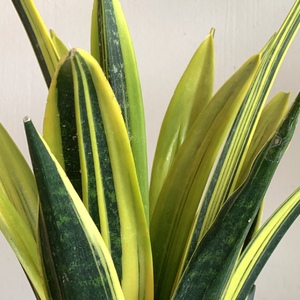
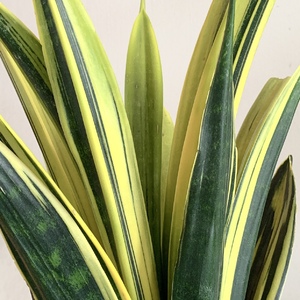


kensong
2018年11月15日

Say hello to my Sansevieria family. They're perfect indoor plants. Forgiving, grow well in indirect or partial shade, can go for weeks without water if you are traveling and purifies your indoor air. What more can you ask of a plant.
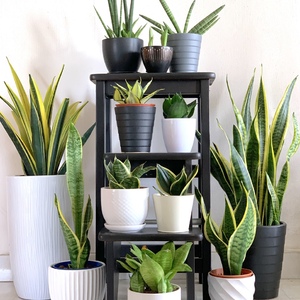

kensong
2018年11月15日

This is my first growing diary. From ESH Landscape RM55.00
